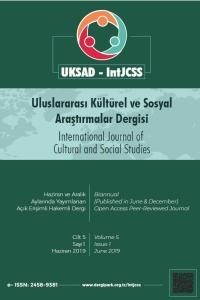Serbest Zaman ve Televizyon İzleme Alışkanlıkları Arasındaki İlişki: Türkiye’deki Ugandalı Öğrenciler Üzerine Bir Araştırma
İnsanın özgürleşmesi ve kendini geliştirmesi için, yaşamın
zorunluluklarının dışında kalan serbest zamanın yerini bugün, medya
teknolojileri doldurmaktadır. İnternet, akıllı telefonlar, bilgisayarlar gibi
giderek maliyeti düşen medya teknolojilerinin toplumun hemen hemen her kesimi
tarafından erişilebilir hale gelecek kadar yaygınlaşması, kitle iletişim
araçlarını insanların gündelik yaşamının birincil aktörleri haline getirmiştir.
İnternet, akıllı telefonlar ve bilgisayarlar gibi yeni medya teknolojilerinin
sayısal olarak çokluğuna rağmen insanlar hala serbest zamanlarında televizyon
izlemektedir. Dünya Gençlik Raporu’na (2003) göre dünyadaki gençler, günde
yaklaşık ortalama iki saat televizyon izlemek için vakit harcamaktadır. Bu araştırma
televizyon izleme eğiliminin serbest zamanı olumlu bir şekilde etkilediği
üzerine kurulmuştur. Çalışmada televizyon izleme eğiliminin öğrencilerin
serbest zamanlarını nasıl etkilediğin tespiti amaçlanmıştır. Ayrıca serbest
zamanlarda öğrenciler tarafından yapılan faaliyetlerin belirlenmesi de önem arz
etmektedir. Bu çalışma, Türkiye'de yaşayan Ugandalı öğrencilerle sınırlıdır. Bu
tespitlerin sağlanabilmesi için nicel araştırma yöntemlerinden anket tekniğine
başvurulmuştur. Çalışmada, çevrimiçi ortamda gerçekleştirilen anketle birlikte
Türkiye’de 8 ilden 107 katılımcının rastgele seçilen bir örneklem üzerinden veri
almak için kullanılan nicel bir yaklaşıma başvurulmuştur. Bulgular, frekans ve
yüzdelerle sunulmuştur. Araştırma sonuçlarına göre katılımcıların büyük
çoğunluğu (% 52.6) serbest zamanlarında televizyon izlemekte ve günde yaklaşık
3-4 saat vakit geçirmektedir. Araştırmaya göre katılımcıların (% 74.5)’i
serbest zamanlarında Uganda televizyon kanallarını izlemeyi tercih etmiştir ve
sadece (% 25.5)’lik kısım; Türk televizyon kanallarını seyretmiştir.
Katılımcıların çoğunluğuna (% 48.6) göre serbest zamanlarda akademik öğrenme
amacıyla televizyon izlenmektedir. Çalışmadan elde edilen sonuçlara göre
serbest zamanlarda televizyon izleme amaçları ise (% 36.4) ile eğlence olmuş,
ancak (% 32.7)’si bilgi ve haber amaçlı televizyon izlediğini ifade etmiştir. Araştırmanın
sonuçlarına göre kitap okuma, gezi, alışveriş alışkanlıkları ve arkadaşlarla
ilişkiler gibi serbest zaman etkinlikleri, televizyon izleme eğiliminden etkilenmektedir.
Sonuç olarak öğrencilerin serbest zaman etkinliklerinde televizyon izlenilmesi,
zihinlerini tazelerken, farklı etkinliklere aktif katılımlarını olumlu yönde teşvik
etmiştir.
Anahtar Kelimeler:
Serbest Zaman, Televizyon İzleme, Öğrenciler, Uganda, Türkiye
The Relationship between Television Watching Habits and Leisure Time: A Research on Ugandan Students in Turkey
Media technologies have become
actors in people's everyday life as they occupy a bigger portion of people’s
leisure time for purposes of self-development and entertainment. Despite the
invention of new media technologies of the Internet,
smartphones, and computers, society still spends time in front of the screen
watching television at a considerable rate. According to the World Youth Report (2003), young people in the
developed world spend an average of about two hours daily in front of the
television and their engagement in active leisure such as sports and the arts
is also greater during their leisure time. This study had hypothesis that
“Watching Television impacts on students’ leisure time activities”. The
objective was; to examine how TV watching influence students’ leisure time
activities. It also aimed at identifying
students’ leisure time activities. This study used a
random sampling technique to select respondents of Ugandan nationality studying
in Turkey. Selected respondents were invited to answer a designed online questionnaire.
A total of N=107 respondents from 8 cities in Turkey took part in the study.
This study’ findings are summarized in frequencies and percentages. The study
showed that on a daily basis the majority of the respondents 52.6% considered
3-4 hours as their leisure time for watching television. The results show that
74.5% of the respondents preferred watching Ugandan television channels during
their leisure time whereas only 25.5%, watched Turkish television channels.
It’s worth noting that 48.6% of the majority respondents agreed that watching
television stimulates their academic learning. Meanwhile 36.4% of the
participants in this study watched television during their leisure time for
entertainment and pleasure purposes and 32.7% watched television for information and news purposes. In the same line 43%
of the respondents agreed that television watching influences their leisure
time activities like book reading, shopping behavior, touring among
others.
Keywords:
Leisure Time, Television Viewership, Students, Uganda, Turkey,
___
- Aydoğan, F. (2000). Medya ve Serbest Zaman, İstanbul: Om Yayınevi.
- Cizmeci, E. (2015). ‘Yeni Medya Ve Serbest Zaman’, İletişim Çalışmaları (ed. Filiz Aydoğan), İstanbul: Derin Yayınları.
- Haworth, J.T. & Veal A. J. (2004). Work and Leisure. New York: Routledge.
- Huegli, V. Ann. (2008) My Hobbies and Leisure Time. Quebec Literacy Working Group. Quebec.
- Mattingly,M. J., & Bianchi, S. M. (2003). Gender Differences In Quantity And Quality Of Free Time: The U.S. experience, Social Forces, (81), p.999–1030.
- Mugoya, Y. (2016). Annual Report for the Ugandan Students Association in Turkey. Istanbul. (Unpublished)
- Roberts, K. (1999) Leisure in Contemporary Society. Wallingford, UK: CAB International. U.S Bureau of Labor Statistics (2014). https://www.bls.gov/opub/ted/2015/time-spent-in-leisure-activities-in-2014-by-gender-age-and-educational-attainment.htm (Access Date: 14 April 2017).
- Veal, A. J. (1992) Definitions of Leisure and Recreation. Australian Journal of Leisure and Recreation, 2(4), 44-48, 52, Republished by School of Leisure, Sport and Tourism, University of Technology, Sydney, as Working Paper No. 4,
- www.business.uts.edu.au/lst/research (Access Date: 12 April 2017).
- Westerik, H., Renckstorf, K., Wester, F., & Lammers, J. (2005). The Situational And Time-Varying Context Of Routines In Television Viewing: An Event History Analysis. Communications, (30), p.155–182.
- Whiteside, E. & Hardin, M. (2011). Women (Not) Watching Women: Leisure Time, Television, and Implications for Televised Coverage of Women’s Sports. Communication, Culture & Critique 4, pp.122–143, International Communication Association.
- World Youth Report, (2003) http://www.un.org/esa/socdev/unyin/documents/ch08.pdf (Access Date: 12 April 2017)
- Başlangıç: 2015
- Yayıncı: Mutlu TÜRKMEN
Sayıdaki Diğer Makaleler
Mustafa Şakir AKGÜL, Bilgehan BAYDİL, Veli Volkan GÜRSES, Hakan KARABIYIK, Mitat KOZ
Murat SARIKABAK, Ender EYÜBOĞLU, Mert AYRANCI
Akut Aerobik Egzersiz Öncesi L-Karnitin Alınımının Kan Yağları Üzerine Etkisi
Veli Volkan GÜRSES, Bilgehan BAYDİL, Mustafa Şakir AKGÜL, Bayram CEYLAN
Veli Volkan GÜRSES, Mustafa Şakir AKGÜL, Bayram CEYLAN, Bilgehan BAYDİL, Şükrü Serdar BALCI
Dekonstrüksiyon Kavramsalında Moda Tasarımı
Kültür Kavramının Sosyal Tarihteki Evrimi
Blogların Dijital İletişiminde Dil Özellikleri
